Detailed Risk Analysis of the Sydney Airport Construction Project
VerifiedAdded on 2023/02/01
|18
|3431
|82
Report
AI Summary
This report provides a comprehensive risk analysis of the Western Sydney International Airport project, also known as the Nancy-Bird Walton Airport. It begins with an overview of the project, including its budget, social and economic rationale, key statistics, scope, and construction phases. The report identifies and analyzes five key risk categories: site risks (delays, political and environmental), material risks (use of low quality materials), design risks (faulty designs leading to structural issues), WHS risks (work, health, and safety risks), and environmental risks (air quality, biodiversity, fuel jettisoning, and water quality). For each risk, the report details the potential consequences. The report also includes a risk mitigation plan, offering strategies to address the identified risks and ensure the project's successful completion. The report concludes by emphasizing the importance of proactive risk management in large-scale infrastructure projects.
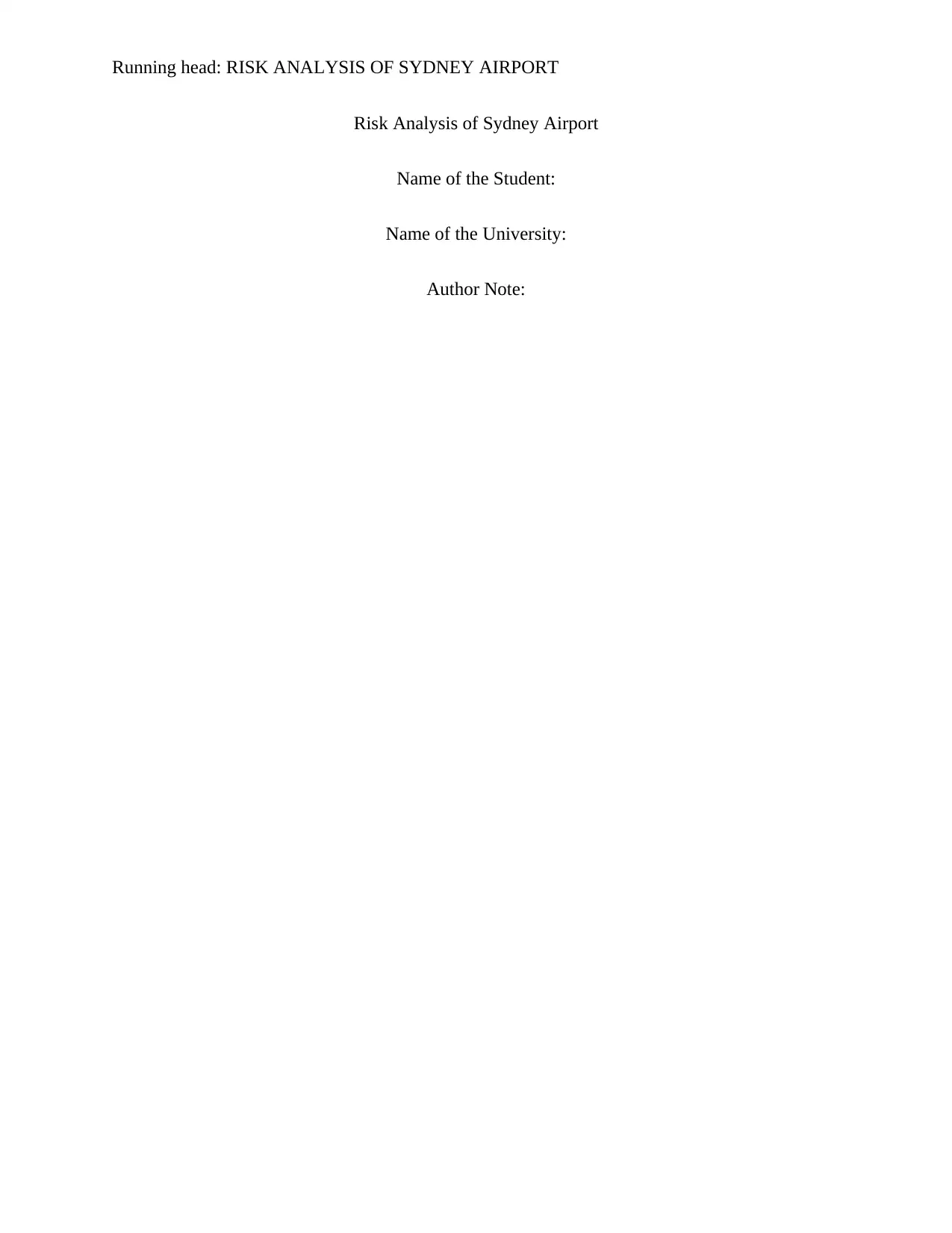
Running head: RISK ANALYSIS OF SYDNEY AIRPORT
Risk Analysis of Sydney Airport
Name of the Student:
Name of the University:
Author Note:
Risk Analysis of Sydney Airport
Name of the Student:
Name of the University:
Author Note:
Paraphrase This Document
Need a fresh take? Get an instant paraphrase of this document with our AI Paraphraser
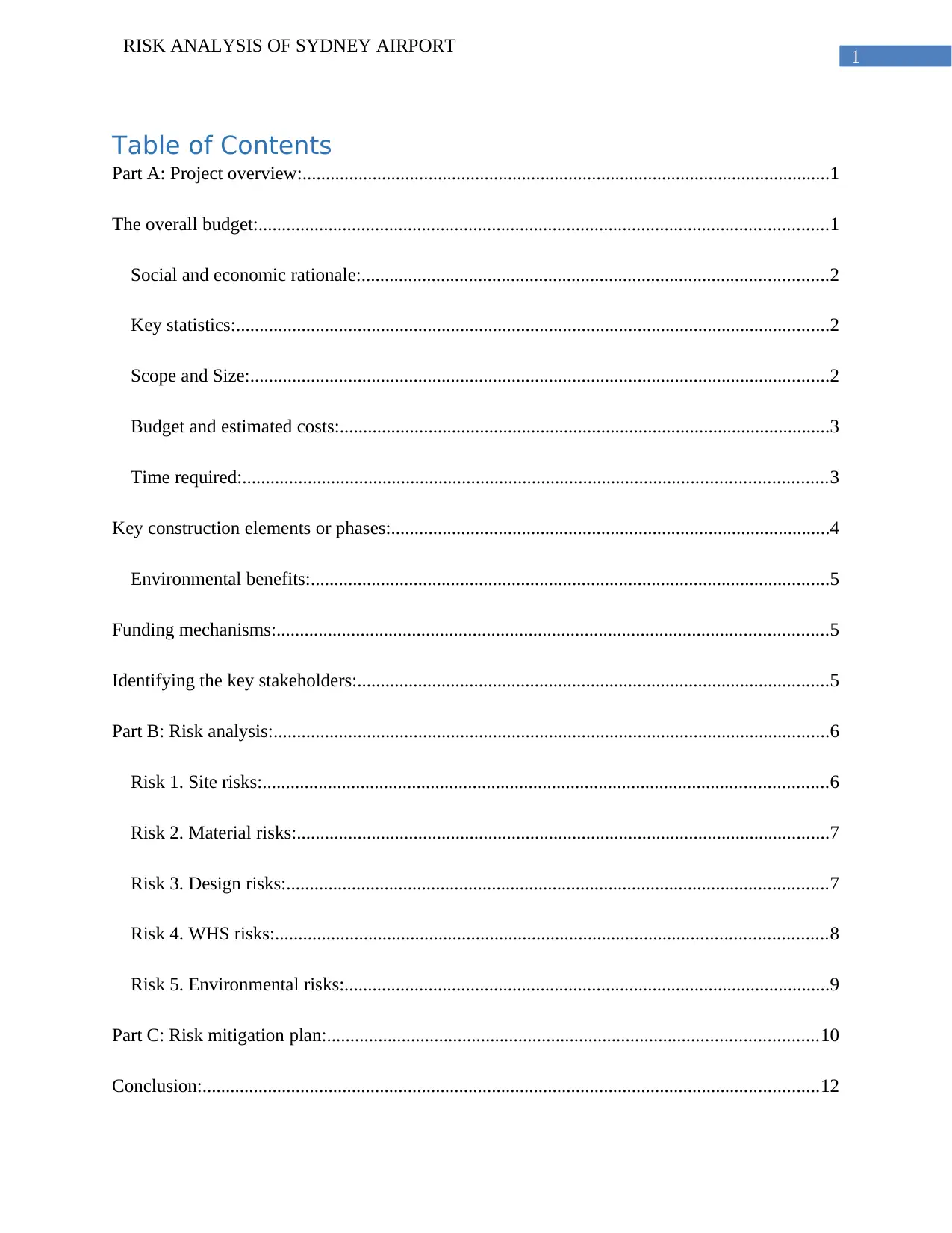
1
RISK ANALYSIS OF SYDNEY AIRPORT
Table of Contents
Part A: Project overview:.................................................................................................................1
The overall budget:..........................................................................................................................1
Social and economic rationale:....................................................................................................2
Key statistics:...............................................................................................................................2
Scope and Size:............................................................................................................................2
Budget and estimated costs:.........................................................................................................3
Time required:.............................................................................................................................3
Key construction elements or phases:..............................................................................................4
Environmental benefits:...............................................................................................................5
Funding mechanisms:......................................................................................................................5
Identifying the key stakeholders:.....................................................................................................5
Part B: Risk analysis:.......................................................................................................................6
Risk 1. Site risks:.........................................................................................................................6
Risk 2. Material risks:..................................................................................................................7
Risk 3. Design risks:....................................................................................................................7
Risk 4. WHS risks:......................................................................................................................8
Risk 5. Environmental risks:........................................................................................................9
Part C: Risk mitigation plan:.........................................................................................................10
Conclusion:....................................................................................................................................12
RISK ANALYSIS OF SYDNEY AIRPORT
Table of Contents
Part A: Project overview:.................................................................................................................1
The overall budget:..........................................................................................................................1
Social and economic rationale:....................................................................................................2
Key statistics:...............................................................................................................................2
Scope and Size:............................................................................................................................2
Budget and estimated costs:.........................................................................................................3
Time required:.............................................................................................................................3
Key construction elements or phases:..............................................................................................4
Environmental benefits:...............................................................................................................5
Funding mechanisms:......................................................................................................................5
Identifying the key stakeholders:.....................................................................................................5
Part B: Risk analysis:.......................................................................................................................6
Risk 1. Site risks:.........................................................................................................................6
Risk 2. Material risks:..................................................................................................................7
Risk 3. Design risks:....................................................................................................................7
Risk 4. WHS risks:......................................................................................................................8
Risk 5. Environmental risks:........................................................................................................9
Part C: Risk mitigation plan:.........................................................................................................10
Conclusion:....................................................................................................................................12

2
RISK ANALYSIS OF SYDNEY AIRPORT
References:....................................................................................................................................13
RISK ANALYSIS OF SYDNEY AIRPORT
References:....................................................................................................................................13
⊘ This is a preview!⊘
Do you want full access?
Subscribe today to unlock all pages.

Trusted by 1+ million students worldwide
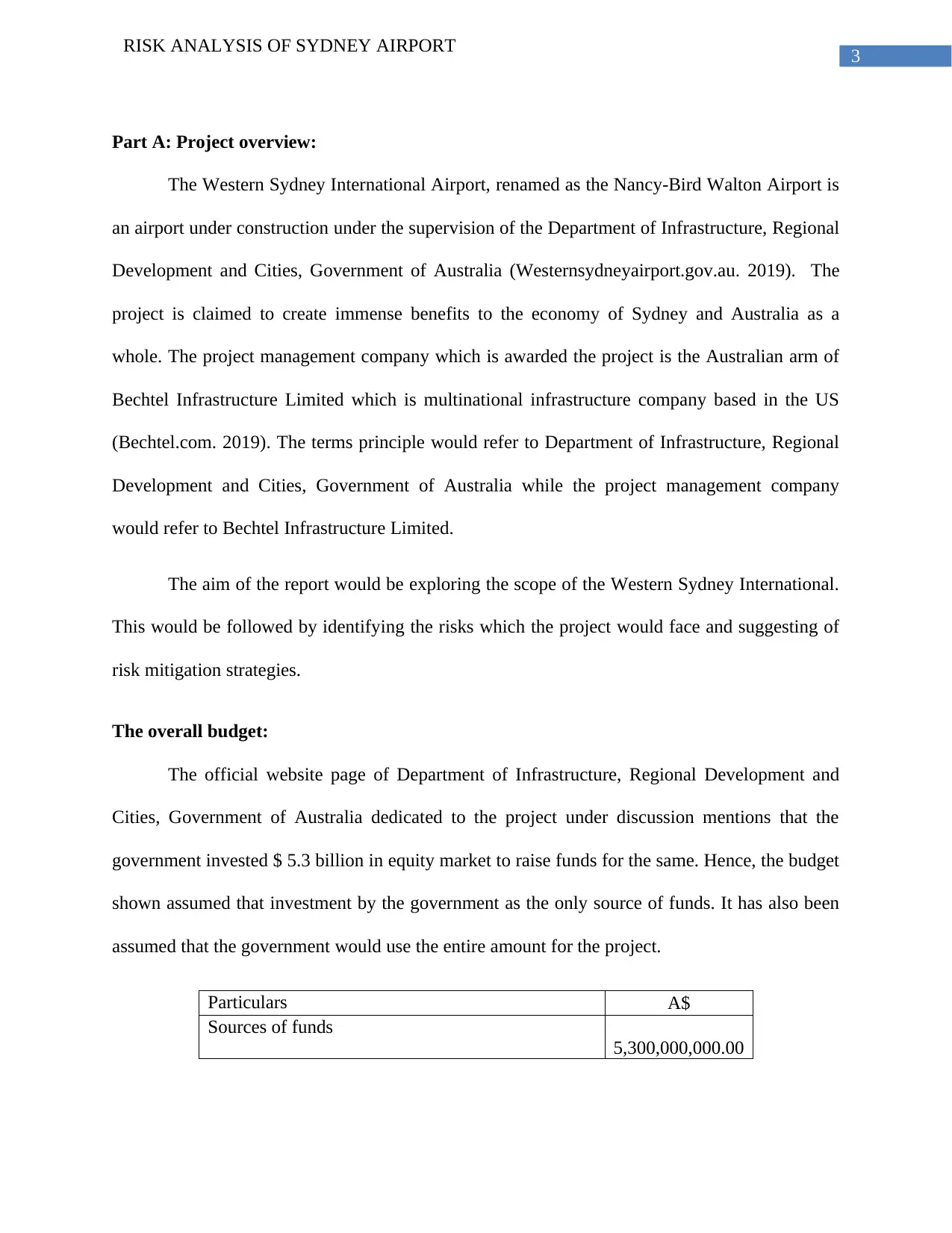
3
RISK ANALYSIS OF SYDNEY AIRPORT
Part A: Project overview:
The Western Sydney International Airport, renamed as the Nancy-Bird Walton Airport is
an airport under construction under the supervision of the Department of Infrastructure, Regional
Development and Cities, Government of Australia (Westernsydneyairport.gov.au. 2019). The
project is claimed to create immense benefits to the economy of Sydney and Australia as a
whole. The project management company which is awarded the project is the Australian arm of
Bechtel Infrastructure Limited which is multinational infrastructure company based in the US
(Bechtel.com. 2019). The terms principle would refer to Department of Infrastructure, Regional
Development and Cities, Government of Australia while the project management company
would refer to Bechtel Infrastructure Limited.
The aim of the report would be exploring the scope of the Western Sydney International.
This would be followed by identifying the risks which the project would face and suggesting of
risk mitigation strategies.
The overall budget:
The official website page of Department of Infrastructure, Regional Development and
Cities, Government of Australia dedicated to the project under discussion mentions that the
government invested $ 5.3 billion in equity market to raise funds for the same. Hence, the budget
shown assumed that investment by the government as the only source of funds. It has also been
assumed that the government would use the entire amount for the project.
Particulars A$
Sources of funds
5,300,000,000.00
RISK ANALYSIS OF SYDNEY AIRPORT
Part A: Project overview:
The Western Sydney International Airport, renamed as the Nancy-Bird Walton Airport is
an airport under construction under the supervision of the Department of Infrastructure, Regional
Development and Cities, Government of Australia (Westernsydneyairport.gov.au. 2019). The
project is claimed to create immense benefits to the economy of Sydney and Australia as a
whole. The project management company which is awarded the project is the Australian arm of
Bechtel Infrastructure Limited which is multinational infrastructure company based in the US
(Bechtel.com. 2019). The terms principle would refer to Department of Infrastructure, Regional
Development and Cities, Government of Australia while the project management company
would refer to Bechtel Infrastructure Limited.
The aim of the report would be exploring the scope of the Western Sydney International.
This would be followed by identifying the risks which the project would face and suggesting of
risk mitigation strategies.
The overall budget:
The official website page of Department of Infrastructure, Regional Development and
Cities, Government of Australia dedicated to the project under discussion mentions that the
government invested $ 5.3 billion in equity market to raise funds for the same. Hence, the budget
shown assumed that investment by the government as the only source of funds. It has also been
assumed that the government would use the entire amount for the project.
Particulars A$
Sources of funds
5,300,000,000.00
Paraphrase This Document
Need a fresh take? Get an instant paraphrase of this document with our AI Paraphraser
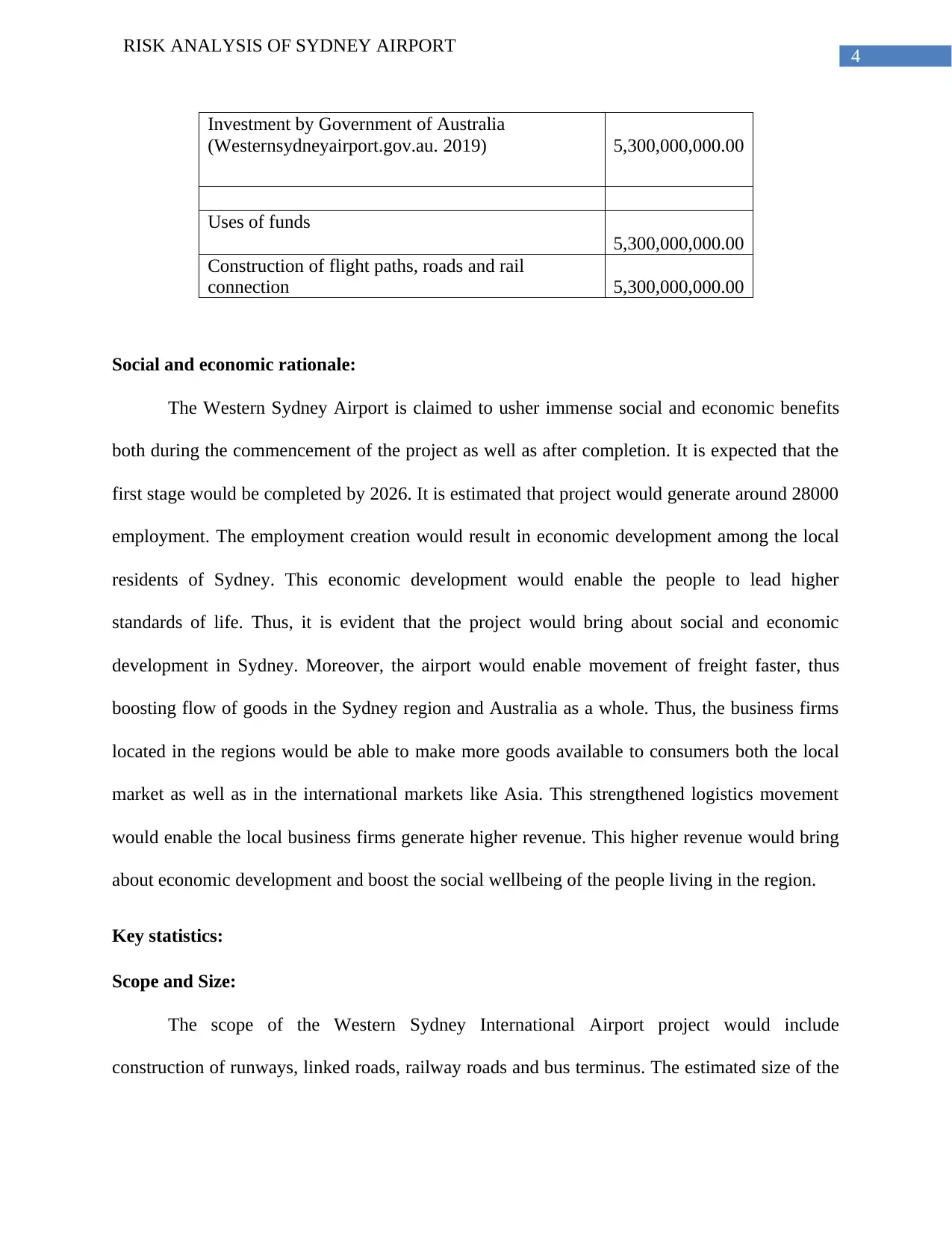
4
RISK ANALYSIS OF SYDNEY AIRPORT
Investment by Government of Australia
(Westernsydneyairport.gov.au. 2019) 5,300,000,000.00
Uses of funds
5,300,000,000.00
Construction of flight paths, roads and rail
connection 5,300,000,000.00
Social and economic rationale:
The Western Sydney Airport is claimed to usher immense social and economic benefits
both during the commencement of the project as well as after completion. It is expected that the
first stage would be completed by 2026. It is estimated that project would generate around 28000
employment. The employment creation would result in economic development among the local
residents of Sydney. This economic development would enable the people to lead higher
standards of life. Thus, it is evident that the project would bring about social and economic
development in Sydney. Moreover, the airport would enable movement of freight faster, thus
boosting flow of goods in the Sydney region and Australia as a whole. Thus, the business firms
located in the regions would be able to make more goods available to consumers both the local
market as well as in the international markets like Asia. This strengthened logistics movement
would enable the local business firms generate higher revenue. This higher revenue would bring
about economic development and boost the social wellbeing of the people living in the region.
Key statistics:
Scope and Size:
The scope of the Western Sydney International Airport project would include
construction of runways, linked roads, railway roads and bus terminus. The estimated size of the
RISK ANALYSIS OF SYDNEY AIRPORT
Investment by Government of Australia
(Westernsydneyairport.gov.au. 2019) 5,300,000,000.00
Uses of funds
5,300,000,000.00
Construction of flight paths, roads and rail
connection 5,300,000,000.00
Social and economic rationale:
The Western Sydney Airport is claimed to usher immense social and economic benefits
both during the commencement of the project as well as after completion. It is expected that the
first stage would be completed by 2026. It is estimated that project would generate around 28000
employment. The employment creation would result in economic development among the local
residents of Sydney. This economic development would enable the people to lead higher
standards of life. Thus, it is evident that the project would bring about social and economic
development in Sydney. Moreover, the airport would enable movement of freight faster, thus
boosting flow of goods in the Sydney region and Australia as a whole. Thus, the business firms
located in the regions would be able to make more goods available to consumers both the local
market as well as in the international markets like Asia. This strengthened logistics movement
would enable the local business firms generate higher revenue. This higher revenue would bring
about economic development and boost the social wellbeing of the people living in the region.
Key statistics:
Scope and Size:
The scope of the Western Sydney International Airport project would include
construction of runways, linked roads, railway roads and bus terminus. The estimated size of the
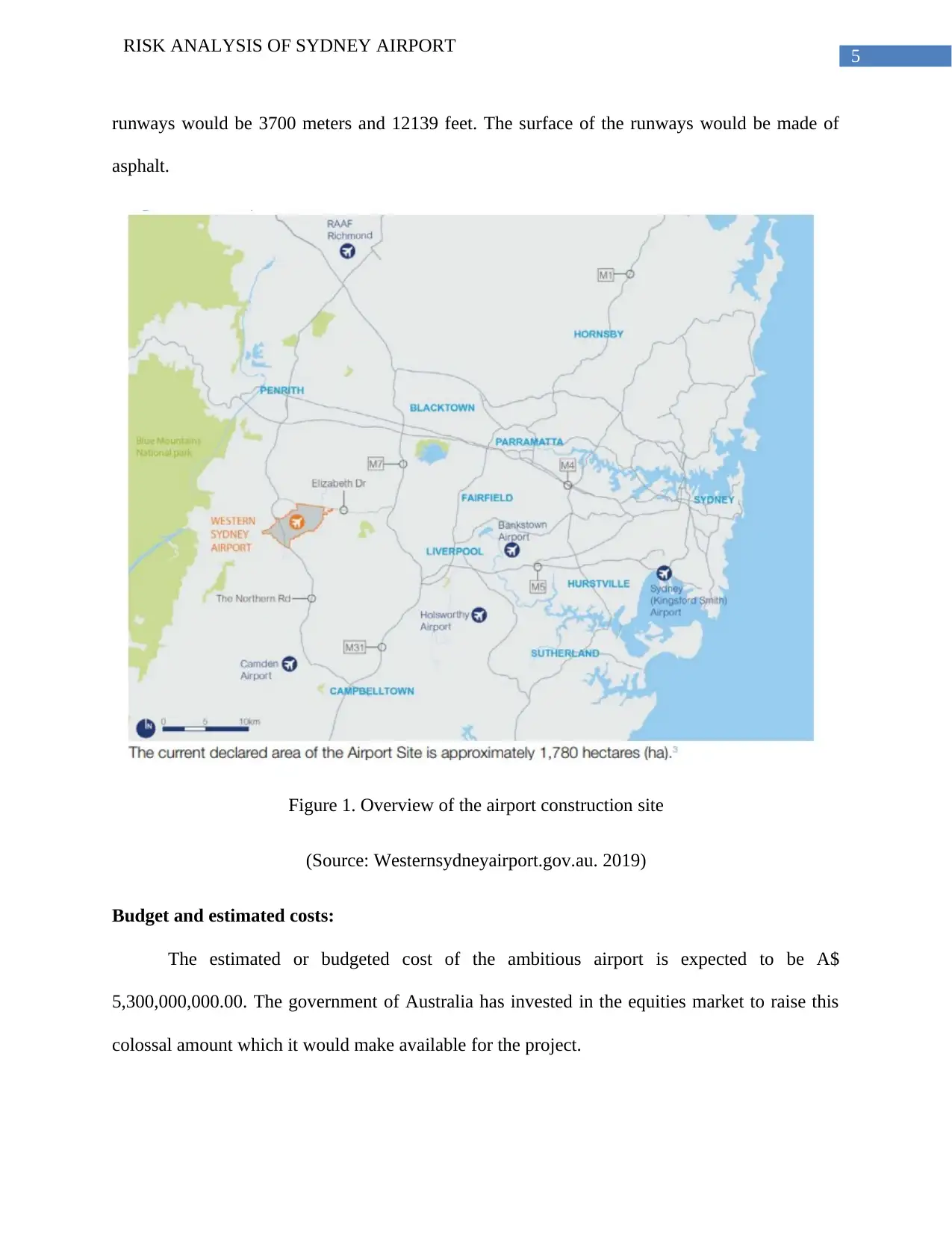
5
RISK ANALYSIS OF SYDNEY AIRPORT
runways would be 3700 meters and 12139 feet. The surface of the runways would be made of
asphalt.
Figure 1. Overview of the airport construction site
(Source: Westernsydneyairport.gov.au. 2019)
Budget and estimated costs:
The estimated or budgeted cost of the ambitious airport is expected to be A$
5,300,000,000.00. The government of Australia has invested in the equities market to raise this
colossal amount which it would make available for the project.
RISK ANALYSIS OF SYDNEY AIRPORT
runways would be 3700 meters and 12139 feet. The surface of the runways would be made of
asphalt.
Figure 1. Overview of the airport construction site
(Source: Westernsydneyairport.gov.au. 2019)
Budget and estimated costs:
The estimated or budgeted cost of the ambitious airport is expected to be A$
5,300,000,000.00. The government of Australia has invested in the equities market to raise this
colossal amount which it would make available for the project.
⊘ This is a preview!⊘
Do you want full access?
Subscribe today to unlock all pages.

Trusted by 1+ million students worldwide
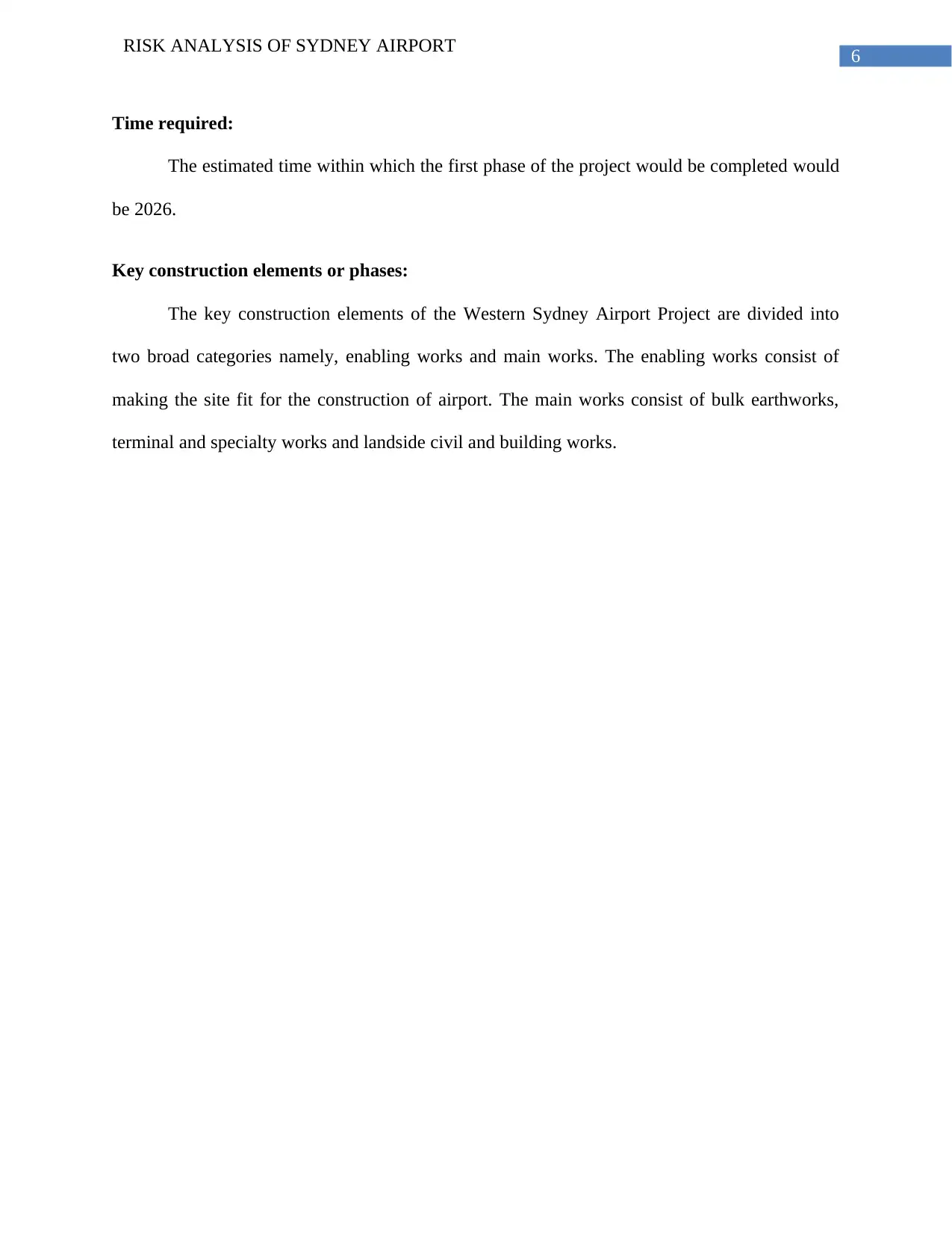
6
RISK ANALYSIS OF SYDNEY AIRPORT
Time required:
The estimated time within which the first phase of the project would be completed would
be 2026.
Key construction elements or phases:
The key construction elements of the Western Sydney Airport Project are divided into
two broad categories namely, enabling works and main works. The enabling works consist of
making the site fit for the construction of airport. The main works consist of bulk earthworks,
terminal and specialty works and landside civil and building works.
RISK ANALYSIS OF SYDNEY AIRPORT
Time required:
The estimated time within which the first phase of the project would be completed would
be 2026.
Key construction elements or phases:
The key construction elements of the Western Sydney Airport Project are divided into
two broad categories namely, enabling works and main works. The enabling works consist of
making the site fit for the construction of airport. The main works consist of bulk earthworks,
terminal and specialty works and landside civil and building works.
Paraphrase This Document
Need a fresh take? Get an instant paraphrase of this document with our AI Paraphraser
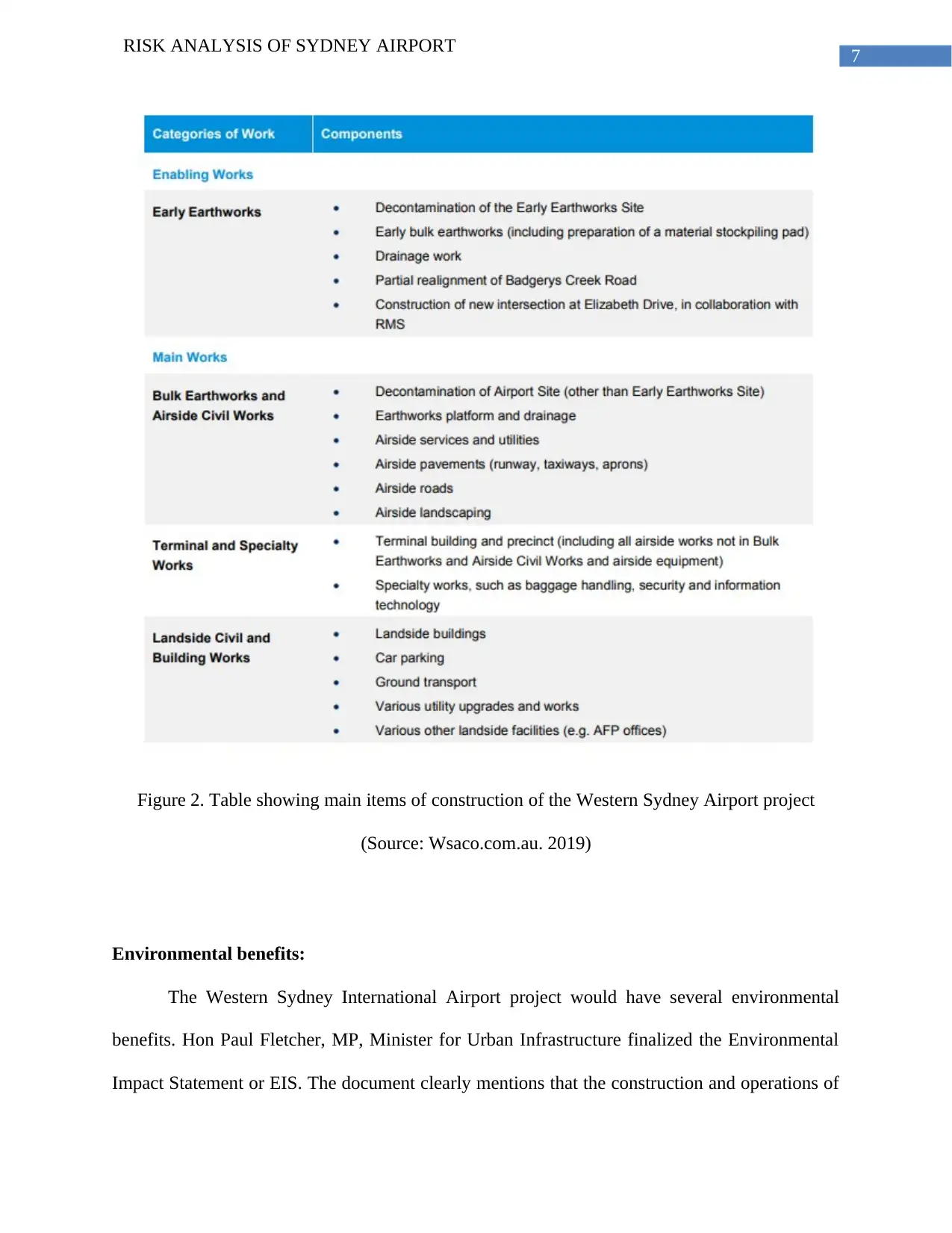
7
RISK ANALYSIS OF SYDNEY AIRPORT
Figure 2. Table showing main items of construction of the Western Sydney Airport project
(Source: Wsaco.com.au. 2019)
Environmental benefits:
The Western Sydney International Airport project would have several environmental
benefits. Hon Paul Fletcher, MP, Minister for Urban Infrastructure finalized the Environmental
Impact Statement or EIS. The document clearly mentions that the construction and operations of
RISK ANALYSIS OF SYDNEY AIRPORT
Figure 2. Table showing main items of construction of the Western Sydney Airport project
(Source: Wsaco.com.au. 2019)
Environmental benefits:
The Western Sydney International Airport project would have several environmental
benefits. Hon Paul Fletcher, MP, Minister for Urban Infrastructure finalized the Environmental
Impact Statement or EIS. The document clearly mentions that the construction and operations of
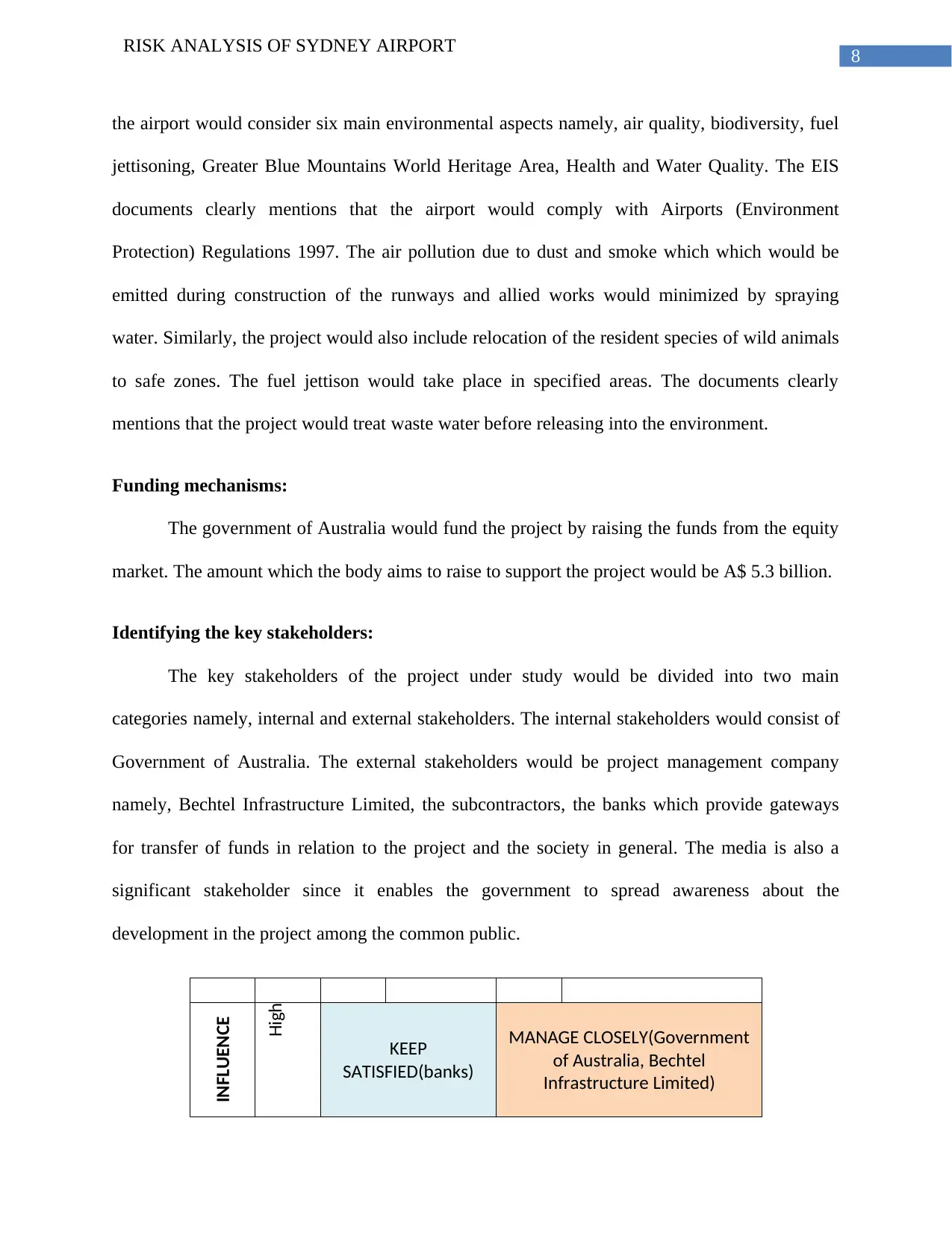
8
RISK ANALYSIS OF SYDNEY AIRPORT
the airport would consider six main environmental aspects namely, air quality, biodiversity, fuel
jettisoning, Greater Blue Mountains World Heritage Area, Health and Water Quality. The EIS
documents clearly mentions that the airport would comply with Airports (Environment
Protection) Regulations 1997. The air pollution due to dust and smoke which which would be
emitted during construction of the runways and allied works would minimized by spraying
water. Similarly, the project would also include relocation of the resident species of wild animals
to safe zones. The fuel jettison would take place in specified areas. The documents clearly
mentions that the project would treat waste water before releasing into the environment.
Funding mechanisms:
The government of Australia would fund the project by raising the funds from the equity
market. The amount which the body aims to raise to support the project would be A$ 5.3 billion.
Identifying the key stakeholders:
The key stakeholders of the project under study would be divided into two main
categories namely, internal and external stakeholders. The internal stakeholders would consist of
Government of Australia. The external stakeholders would be project management company
namely, Bechtel Infrastructure Limited, the subcontractors, the banks which provide gateways
for transfer of funds in relation to the project and the society in general. The media is also a
significant stakeholder since it enables the government to spread awareness about the
development in the project among the common public.
INFLUENCE
High
KEEP
SATISFIED(banks)
MANAGE CLOSELY(Government
of Australia, Bechtel
Infrastructure Limited)
RISK ANALYSIS OF SYDNEY AIRPORT
the airport would consider six main environmental aspects namely, air quality, biodiversity, fuel
jettisoning, Greater Blue Mountains World Heritage Area, Health and Water Quality. The EIS
documents clearly mentions that the airport would comply with Airports (Environment
Protection) Regulations 1997. The air pollution due to dust and smoke which which would be
emitted during construction of the runways and allied works would minimized by spraying
water. Similarly, the project would also include relocation of the resident species of wild animals
to safe zones. The fuel jettison would take place in specified areas. The documents clearly
mentions that the project would treat waste water before releasing into the environment.
Funding mechanisms:
The government of Australia would fund the project by raising the funds from the equity
market. The amount which the body aims to raise to support the project would be A$ 5.3 billion.
Identifying the key stakeholders:
The key stakeholders of the project under study would be divided into two main
categories namely, internal and external stakeholders. The internal stakeholders would consist of
Government of Australia. The external stakeholders would be project management company
namely, Bechtel Infrastructure Limited, the subcontractors, the banks which provide gateways
for transfer of funds in relation to the project and the society in general. The media is also a
significant stakeholder since it enables the government to spread awareness about the
development in the project among the common public.
INFLUENCE
High
KEEP
SATISFIED(banks)
MANAGE CLOSELY(Government
of Australia, Bechtel
Infrastructure Limited)
⊘ This is a preview!⊘
Do you want full access?
Subscribe today to unlock all pages.

Trusted by 1+ million students worldwide
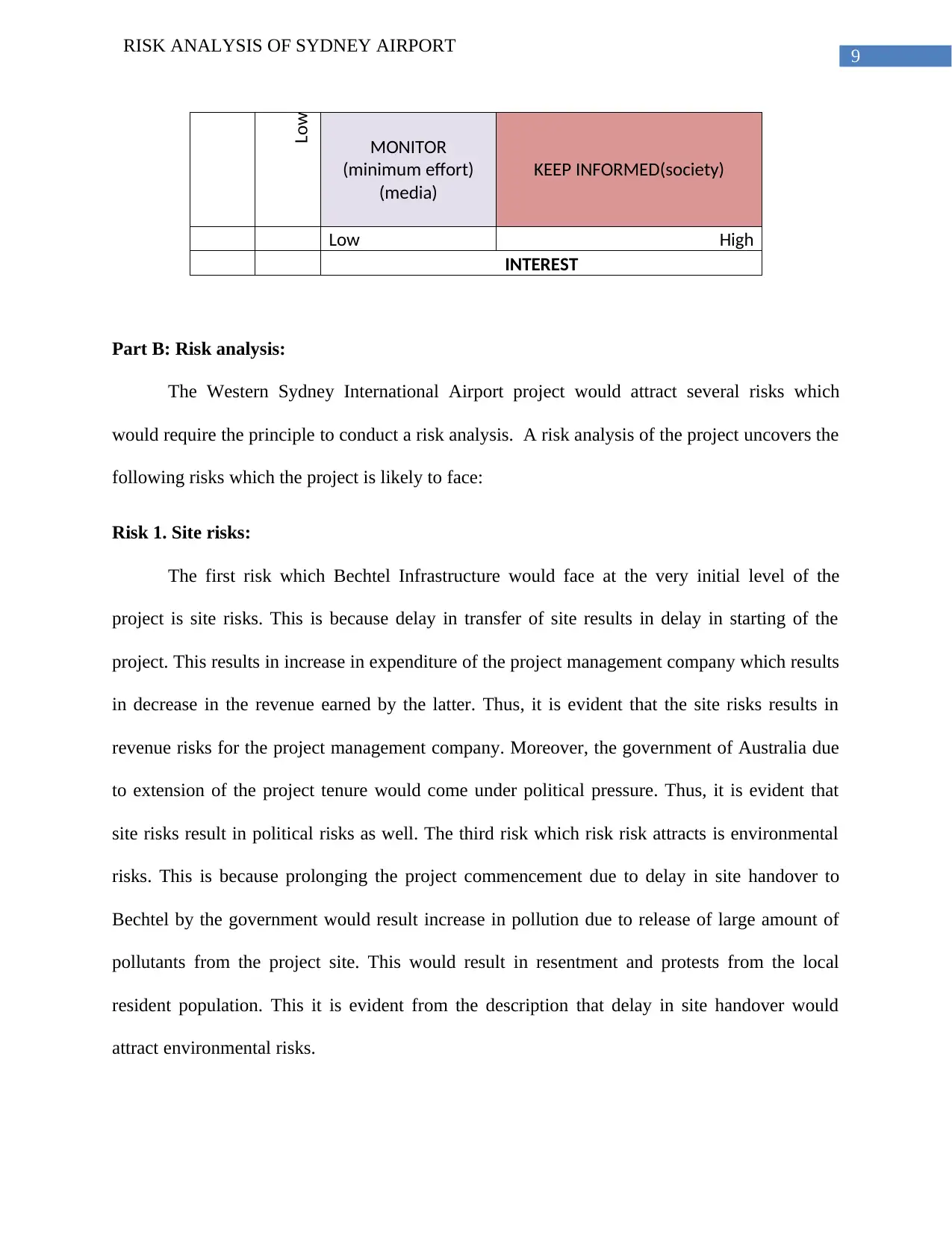
9
RISK ANALYSIS OF SYDNEY AIRPORT
Low
MONITOR
(minimum effort)
(media)
KEEP INFORMED(society)
Low High
INTEREST
Part B: Risk analysis:
The Western Sydney International Airport project would attract several risks which
would require the principle to conduct a risk analysis. A risk analysis of the project uncovers the
following risks which the project is likely to face:
Risk 1. Site risks:
The first risk which Bechtel Infrastructure would face at the very initial level of the
project is site risks. This is because delay in transfer of site results in delay in starting of the
project. This results in increase in expenditure of the project management company which results
in decrease in the revenue earned by the latter. Thus, it is evident that the site risks results in
revenue risks for the project management company. Moreover, the government of Australia due
to extension of the project tenure would come under political pressure. Thus, it is evident that
site risks result in political risks as well. The third risk which risk risk attracts is environmental
risks. This is because prolonging the project commencement due to delay in site handover to
Bechtel by the government would result increase in pollution due to release of large amount of
pollutants from the project site. This would result in resentment and protests from the local
resident population. This it is evident from the description that delay in site handover would
attract environmental risks.
RISK ANALYSIS OF SYDNEY AIRPORT
Low
MONITOR
(minimum effort)
(media)
KEEP INFORMED(society)
Low High
INTEREST
Part B: Risk analysis:
The Western Sydney International Airport project would attract several risks which
would require the principle to conduct a risk analysis. A risk analysis of the project uncovers the
following risks which the project is likely to face:
Risk 1. Site risks:
The first risk which Bechtel Infrastructure would face at the very initial level of the
project is site risks. This is because delay in transfer of site results in delay in starting of the
project. This results in increase in expenditure of the project management company which results
in decrease in the revenue earned by the latter. Thus, it is evident that the site risks results in
revenue risks for the project management company. Moreover, the government of Australia due
to extension of the project tenure would come under political pressure. Thus, it is evident that
site risks result in political risks as well. The third risk which risk risk attracts is environmental
risks. This is because prolonging the project commencement due to delay in site handover to
Bechtel by the government would result increase in pollution due to release of large amount of
pollutants from the project site. This would result in resentment and protests from the local
resident population. This it is evident from the description that delay in site handover would
attract environmental risks.
Paraphrase This Document
Need a fresh take? Get an instant paraphrase of this document with our AI Paraphraser
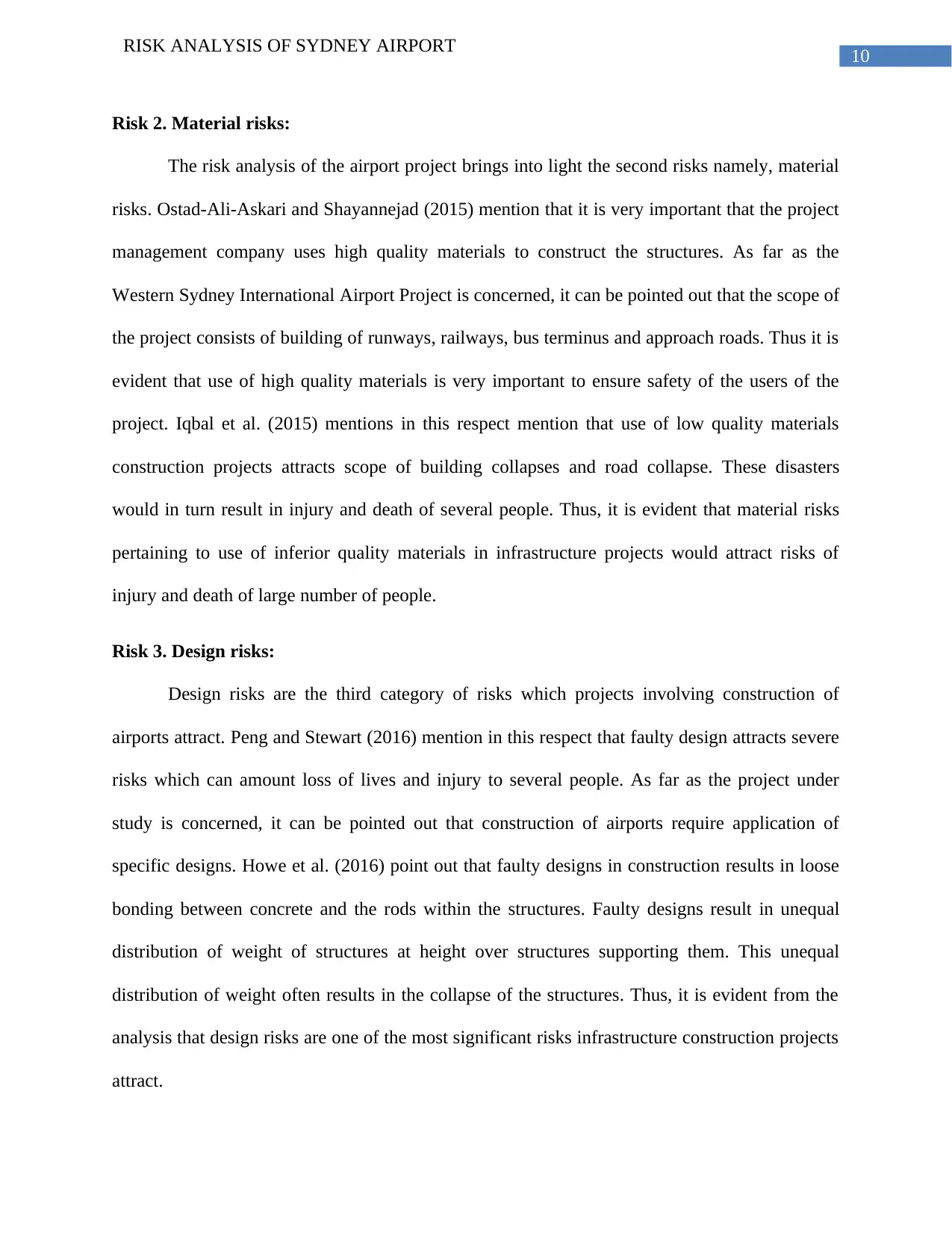
10
RISK ANALYSIS OF SYDNEY AIRPORT
Risk 2. Material risks:
The risk analysis of the airport project brings into light the second risks namely, material
risks. Ostad-Ali-Askari and Shayannejad (2015) mention that it is very important that the project
management company uses high quality materials to construct the structures. As far as the
Western Sydney International Airport Project is concerned, it can be pointed out that the scope of
the project consists of building of runways, railways, bus terminus and approach roads. Thus it is
evident that use of high quality materials is very important to ensure safety of the users of the
project. Iqbal et al. (2015) mentions in this respect mention that use of low quality materials
construction projects attracts scope of building collapses and road collapse. These disasters
would in turn result in injury and death of several people. Thus, it is evident that material risks
pertaining to use of inferior quality materials in infrastructure projects would attract risks of
injury and death of large number of people.
Risk 3. Design risks:
Design risks are the third category of risks which projects involving construction of
airports attract. Peng and Stewart (2016) mention in this respect that faulty design attracts severe
risks which can amount loss of lives and injury to several people. As far as the project under
study is concerned, it can be pointed out that construction of airports require application of
specific designs. Howe et al. (2016) point out that faulty designs in construction results in loose
bonding between concrete and the rods within the structures. Faulty designs result in unequal
distribution of weight of structures at height over structures supporting them. This unequal
distribution of weight often results in the collapse of the structures. Thus, it is evident from the
analysis that design risks are one of the most significant risks infrastructure construction projects
attract.
RISK ANALYSIS OF SYDNEY AIRPORT
Risk 2. Material risks:
The risk analysis of the airport project brings into light the second risks namely, material
risks. Ostad-Ali-Askari and Shayannejad (2015) mention that it is very important that the project
management company uses high quality materials to construct the structures. As far as the
Western Sydney International Airport Project is concerned, it can be pointed out that the scope of
the project consists of building of runways, railways, bus terminus and approach roads. Thus it is
evident that use of high quality materials is very important to ensure safety of the users of the
project. Iqbal et al. (2015) mentions in this respect mention that use of low quality materials
construction projects attracts scope of building collapses and road collapse. These disasters
would in turn result in injury and death of several people. Thus, it is evident that material risks
pertaining to use of inferior quality materials in infrastructure projects would attract risks of
injury and death of large number of people.
Risk 3. Design risks:
Design risks are the third category of risks which projects involving construction of
airports attract. Peng and Stewart (2016) mention in this respect that faulty design attracts severe
risks which can amount loss of lives and injury to several people. As far as the project under
study is concerned, it can be pointed out that construction of airports require application of
specific designs. Howe et al. (2016) point out that faulty designs in construction results in loose
bonding between concrete and the rods within the structures. Faulty designs result in unequal
distribution of weight of structures at height over structures supporting them. This unequal
distribution of weight often results in the collapse of the structures. Thus, it is evident from the
analysis that design risks are one of the most significant risks infrastructure construction projects
attract.
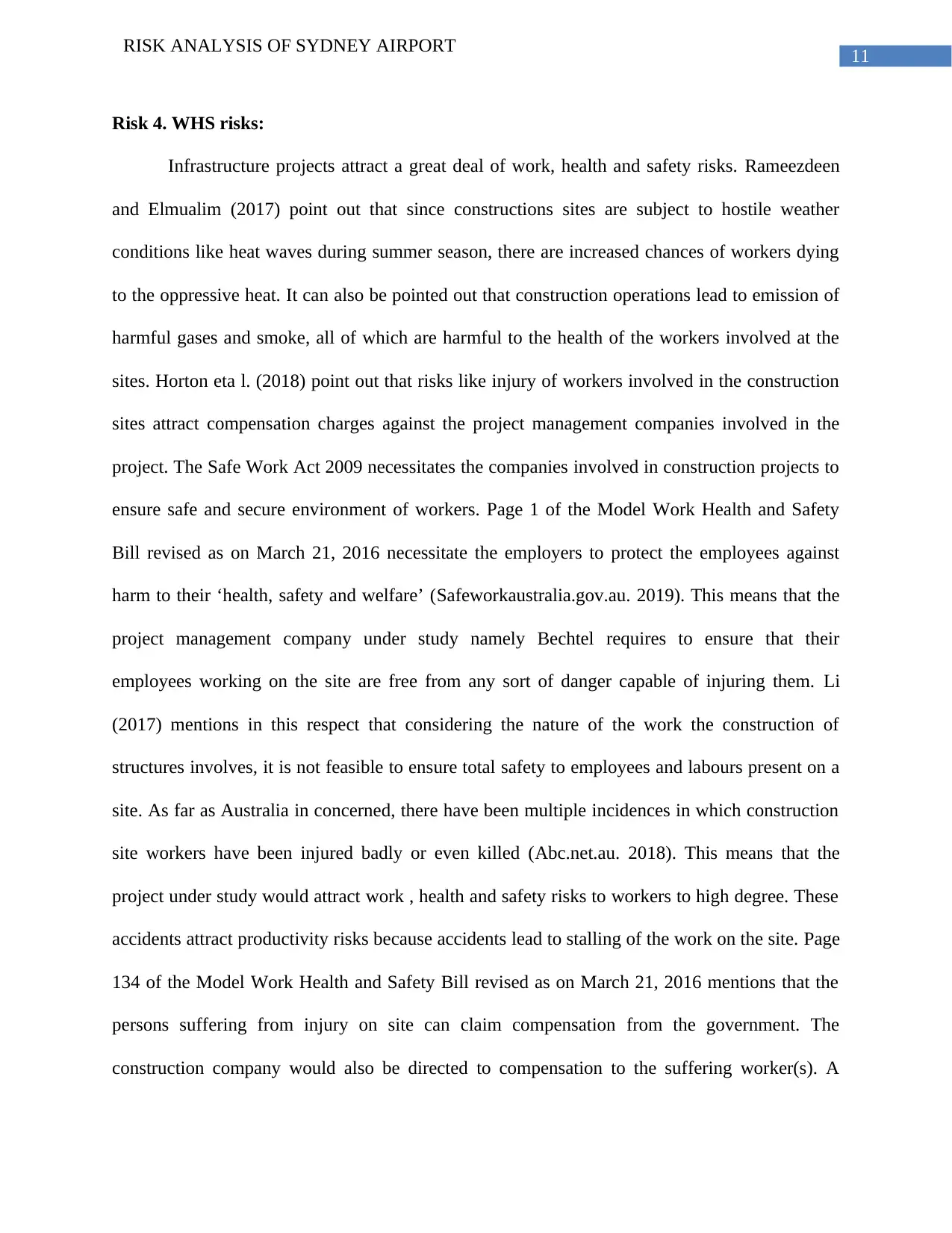
11
RISK ANALYSIS OF SYDNEY AIRPORT
Risk 4. WHS risks:
Infrastructure projects attract a great deal of work, health and safety risks. Rameezdeen
and Elmualim (2017) point out that since constructions sites are subject to hostile weather
conditions like heat waves during summer season, there are increased chances of workers dying
to the oppressive heat. It can also be pointed out that construction operations lead to emission of
harmful gases and smoke, all of which are harmful to the health of the workers involved at the
sites. Horton eta l. (2018) point out that risks like injury of workers involved in the construction
sites attract compensation charges against the project management companies involved in the
project. The Safe Work Act 2009 necessitates the companies involved in construction projects to
ensure safe and secure environment of workers. Page 1 of the Model Work Health and Safety
Bill revised as on March 21, 2016 necessitate the employers to protect the employees against
harm to their ‘health, safety and welfare’ (Safeworkaustralia.gov.au. 2019). This means that the
project management company under study namely Bechtel requires to ensure that their
employees working on the site are free from any sort of danger capable of injuring them. Li
(2017) mentions in this respect that considering the nature of the work the construction of
structures involves, it is not feasible to ensure total safety to employees and labours present on a
site. As far as Australia in concerned, there have been multiple incidences in which construction
site workers have been injured badly or even killed (Abc.net.au. 2018). This means that the
project under study would attract work , health and safety risks to workers to high degree. These
accidents attract productivity risks because accidents lead to stalling of the work on the site. Page
134 of the Model Work Health and Safety Bill revised as on March 21, 2016 mentions that the
persons suffering from injury on site can claim compensation from the government. The
construction company would also be directed to compensation to the suffering worker(s). A
RISK ANALYSIS OF SYDNEY AIRPORT
Risk 4. WHS risks:
Infrastructure projects attract a great deal of work, health and safety risks. Rameezdeen
and Elmualim (2017) point out that since constructions sites are subject to hostile weather
conditions like heat waves during summer season, there are increased chances of workers dying
to the oppressive heat. It can also be pointed out that construction operations lead to emission of
harmful gases and smoke, all of which are harmful to the health of the workers involved at the
sites. Horton eta l. (2018) point out that risks like injury of workers involved in the construction
sites attract compensation charges against the project management companies involved in the
project. The Safe Work Act 2009 necessitates the companies involved in construction projects to
ensure safe and secure environment of workers. Page 1 of the Model Work Health and Safety
Bill revised as on March 21, 2016 necessitate the employers to protect the employees against
harm to their ‘health, safety and welfare’ (Safeworkaustralia.gov.au. 2019). This means that the
project management company under study namely Bechtel requires to ensure that their
employees working on the site are free from any sort of danger capable of injuring them. Li
(2017) mentions in this respect that considering the nature of the work the construction of
structures involves, it is not feasible to ensure total safety to employees and labours present on a
site. As far as Australia in concerned, there have been multiple incidences in which construction
site workers have been injured badly or even killed (Abc.net.au. 2018). This means that the
project under study would attract work , health and safety risks to workers to high degree. These
accidents attract productivity risks because accidents lead to stalling of the work on the site. Page
134 of the Model Work Health and Safety Bill revised as on March 21, 2016 mentions that the
persons suffering from injury on site can claim compensation from the government. The
construction company would also be directed to compensation to the suffering worker(s). A
⊘ This is a preview!⊘
Do you want full access?
Subscribe today to unlock all pages.

Trusted by 1+ million students worldwide
1 out of 18
Related Documents
Your All-in-One AI-Powered Toolkit for Academic Success.
+13062052269
info@desklib.com
Available 24*7 on WhatsApp / Email
![[object Object]](/_next/static/media/star-bottom.7253800d.svg)
Unlock your academic potential
Copyright © 2020–2025 A2Z Services. All Rights Reserved. Developed and managed by ZUCOL.



